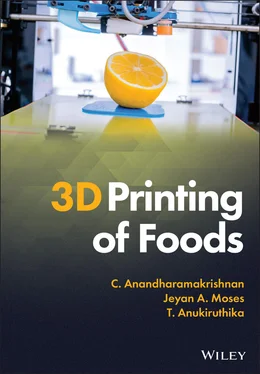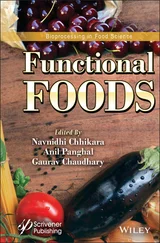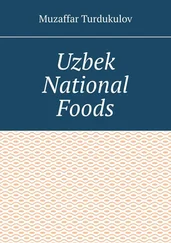C. Anandharamakrishnan - 3D Printing of Foods
Здесь есть возможность читать онлайн «C. Anandharamakrishnan - 3D Printing of Foods» — ознакомительный отрывок электронной книги совершенно бесплатно, а после прочтения отрывка купить полную версию. В некоторых случаях можно слушать аудио, скачать через торрент в формате fb2 и присутствует краткое содержание. Жанр: unrecognised, на английском языке. Описание произведения, (предисловие) а так же отзывы посетителей доступны на портале библиотеки ЛибКат.
- Название:3D Printing of Foods
- Автор:
- Жанр:
- Год:неизвестен
- ISBN:нет данных
- Рейтинг книги:3 / 5. Голосов: 1
-
Избранное:Добавить в избранное
- Отзывы:
-
Ваша оценка:
- 60
- 1
- 2
- 3
- 4
- 5
3D Printing of Foods: краткое содержание, описание и аннотация
Предлагаем к чтению аннотацию, описание, краткое содержание или предисловие (зависит от того, что написал сам автор книги «3D Printing of Foods»). Если вы не нашли необходимую информацию о книге — напишите в комментариях, мы постараемся отыскать её.
Explore the fascinating realm of 3D food printing and its applications 3D Printing of Foods
3D Printing of Foods
3D Printing of Foods
3D Printing of Foods — читать онлайн ознакомительный отрывок
Ниже представлен текст книги, разбитый по страницам. Система сохранения места последней прочитанной страницы, позволяет с удобством читать онлайн бесплатно книгу «3D Printing of Foods», без необходимости каждый раз заново искать на чём Вы остановились. Поставьте закладку, и сможете в любой момент перейти на страницу, на которой закончили чтение.
Интервал:
Закладка:

Figure 3.1 Schematic representation of gelation mechanism of starch granules.
Researchers are quite interested in exploring the printability of common daily foods such as cereals and millets, legumes and pulses, fruits and vegetables, dairy products and meat products. Rice a staple food of South Asia is widely consumed and forms a major part of the regular diet (Ramadoss et al. 2019). Huang et al. (2019) have reported a study on the assessment of printability of brown rice and evaluated its effect on end‐product quality. In this study, ready-to-cook (RTC) brown rice flour was prepared and used for printing trials. Material supply was pre‐gelatinised in order to enhance the chemical integrity of starch molecules. Granule size, amylose, and amylopectin content of flour determined its pasting behaviour (Huang et al. 2019). This could be correlated with the swelling power and gelling behaviour of starch molecules. The formation of hydrogen bonds and corresponding molecular entanglement had a significant impact on textural properties such as the hardness and gumminess of the 3D printed sample.
In another study, mashed potato along with potato starch (0, 1, 2, and 4%, w/w) was used for 3D printing. Raw potatoes were steam cooked and ground to form smooth paste making them suitable for extrusion‐based printing. Application of heat causes the molecules to swell due to which the amorphous nature of the starch molecules was increased with a decrease in their crystallinity. Upon subsequent cooling, the starch mixture would reverse the process to regain its crystalline nature that leads to the formation of a gel. The strong association of hydrogen bonds between water and starch forms a dense network imparting a smooth texture for material supply making it easy for extrudability and hence 3D printing of starch‐based food mixtures (Liu et al. 2018).
Southerland et al. (2011) reported a study on printing a mixture of starch, sugar, and mashed potato as dry fractions using a Z Corporation 3D printer to fabricate teeth like prototypes based on sugar crystals. These type of 3D printers employs a heat source for binding and fusion of materials based on sintering process thereby forming a 3D edible construct. Sintering is a solid‐state process involving the melting of solid particles to their melting point that leads to the formation of grain boundaries between grain‐void interfaces ( Figure 3.2). In the case of sugar crystals, the molecular voids open out forming the fusion of particles together with the application of heat and slight pressure. 3D printing of sugars greatly depends on properties like crystallinity, melting point, source and extent of heating, glass transition temperature ( T g), compressibility, solubility, and material density. These parameters greatly influence the porosity of fabricated structures and hence the texture of 3D printed candies could be controlled. Similarly, 3D systems had fabricated sugar cubes from milk chocolates, sweet, and sour candies (Sun et al. 2015).
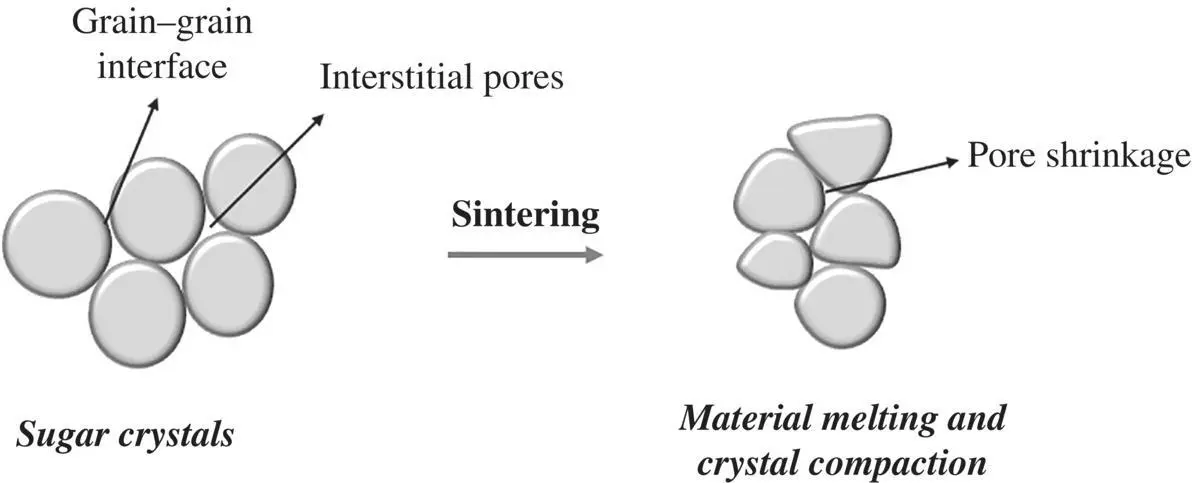
Figure 3.2 Schematic representation of sintering process.
3.4.2 Proteins and Amino Acids
Proteins are a complex group of biopolymers that consists of long chains of linear and branched amino acids linked together by peptide bonds. Chemical break down of proteins could result in a shorter chain amino acid that forms a precursor to nucleic acid, antigen, antibodies, hormones, and co‐enzymes. Proteins play a vital role in imparting structural integrity to cell walls and stiffness to tissues. Other functional role includes regulation of physiological activities, maintenance of normal pH, acts as chemical messenger, and storage pool (Hoffman 2019). Legumes and pulses are a good source of proteins from a plant source. Proteins from the animal source include eggs, red meat, fish, and dairy products such as cheese and whey powders. Based on the amino acid profile, proteins from animal sources are considered as complete proteins while plant proteins are considered incomplete due to lack of one or more essential amino acids. Various factors that affect the functionality and availability of proteins includes heat, pH (acid/ base), enzymatic hydrolysis that leads to denaturation, aggregation, and cross‐linking of proteins (Lassé et al. 2015). These properties in turn affect the printability of native proteins. Proteins being an important macronutrient for bodybuilding, several kinds of research were being conducted focussing on the effect of physicochemical properties on the printability of protein‐based food systems. When subjected to external stress such as heat, acidic/ basic conditions, and mechanical agitation proteins undergo denaturation. The production process of various food products such as cheese, tofu, minced meat, etc., involves simultaneous denaturation and coagulation of protein molecules that enhance the textural properties of the final product (Xiong 2018). Protein denaturation refers to the breakdown of secondary and tertiary structures that has a significant effect on modifying the texture of food products and hence mouth feel.
Modification of textures of food being one of the potential applications of food 3D printing, the printability of the processed cheese was examined by Le Tohic et al. (2018) in which the effect of the printing process on structural properties of hot‐melt cheese was reported ( Figure 3.3). Different cheese samples (untreated cheese, melted cheese, and printed cheese) were analysed for their hardness. Results showed that printed cheese was found to be less hard than other samples. The lesser hardness of the printed cheese was attributed to the material’s meltability, and the associated shear stress exhibited during extrudability. The weaker bonds of casein molecules of the printed cheese were responsible for its soft texture and ease of flowability. Combined effects of material shearing during printing and solidification of which during the after‐printing process resulted in the coalescence of fat globules. The resulted food system with disrupted fat globules embedded in the protein matrix imparts the tendency of melt‐in‐mouth texture to the 3D printed cheese. Proteins alone are not conducive for 3D printing, proteins along with other food constituents either with lipids or starch aids in printability as they act as a plasticizing agent. This could be due to the synergistic effects of proteins in combination with other macronutrients that increase crosslinking and hence improve the strength of the gel matrix. These characteristics greatly influence materials viscosity and stability of printed structures.
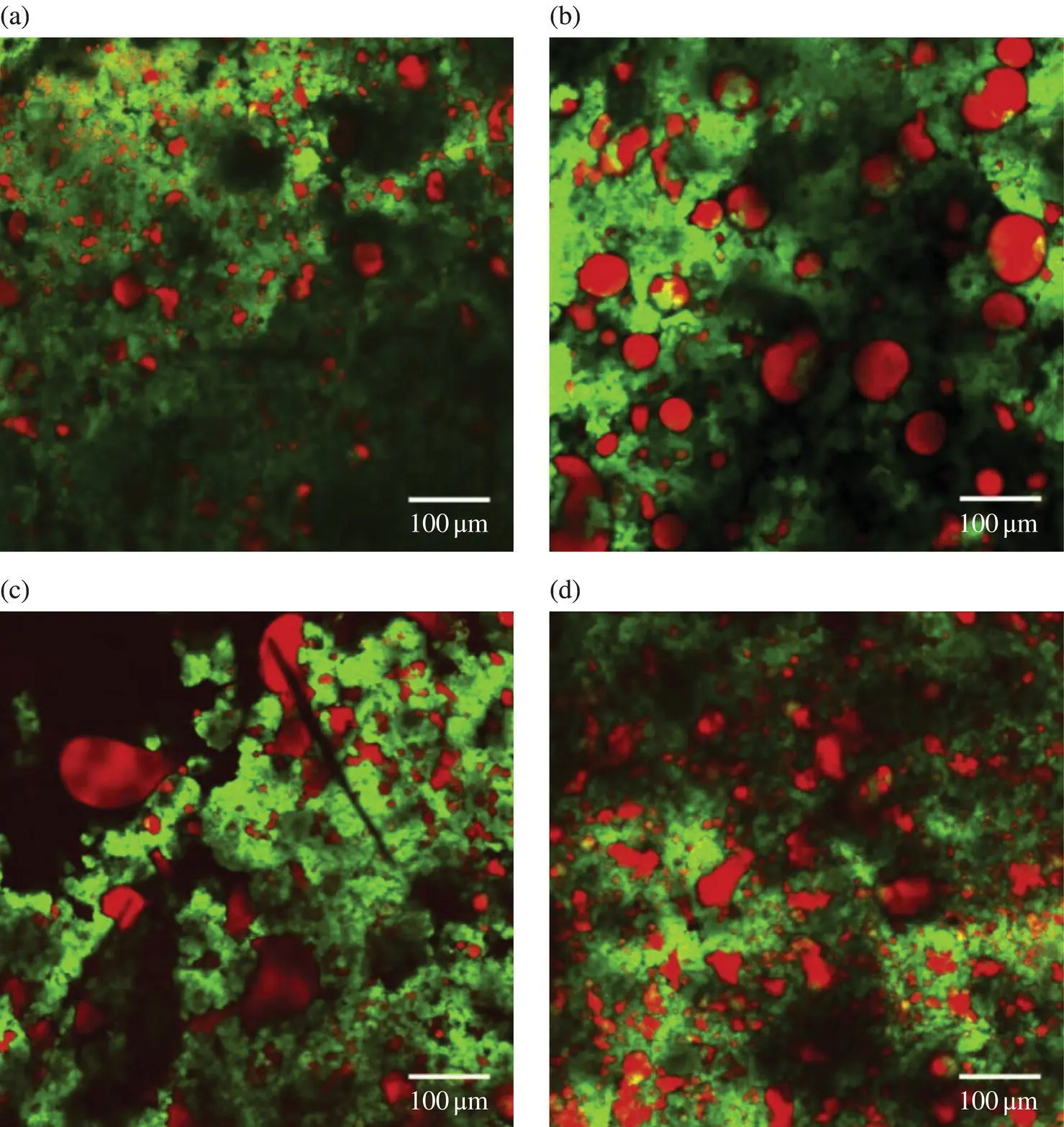
Figure 3.3 Confocal micrographs of cheese sample showing distribution of fat globules (pigmented spots) in a protein matrix (a) untreated cheese, (b) melted cheese, (c) low speed printed cheese, (d) high speed printed cheese.
Source: From Le Tohic et al. (2018), Figure 05 [p. 61] / With permission of Elsevier. DOI‐ https://doi.org/10.1016/j.jfoodeng.2017.02.003.
In another work, Dong et al. (2019) reported a study on the printability of surimi gel with sweet potato starch as a potential structural enhancer for 3D printing. Conventional processing of multi-step surimi preparation deteriorates the gel quality that may not possess enough strength for 3D constructs. Hence, sweet potato starch (0, 2, 6, 8, and 10%, w/w) was used for enhancing the rheological properties of surimi gel. Results showed that surimi gel with 8% sweet potato starch possesses good gel strength with a softer texture. This was due to the cross‐linking of myofibrillar fish proteins with sweet potato starch that forms a uniform aggregate structure making it suitable for 3D printing.
Читать дальшеИнтервал:
Закладка:
Похожие книги на «3D Printing of Foods»
Представляем Вашему вниманию похожие книги на «3D Printing of Foods» списком для выбора. Мы отобрали схожую по названию и смыслу литературу в надежде предоставить читателям больше вариантов отыскать новые, интересные, ещё непрочитанные произведения.
Обсуждение, отзывы о книге «3D Printing of Foods» и просто собственные мнения читателей. Оставьте ваши комментарии, напишите, что Вы думаете о произведении, его смысле или главных героях. Укажите что конкретно понравилось, а что нет, и почему Вы так считаете.
